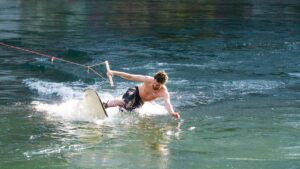Over the course of twenty-five years, my experience with kneeboarding has taught me a number of lessons. Glory, high fives, and ice cream for new tricks were some of the benefits, but face-plants, tired muscles, and aggravation were more common.
The years have taught me ten things you can do to avoid the pain and enjoy ice cream new-tricks and high fives.
1: Strengthen And Stretch
The most prevalent misconception about kneeboarding is that it is harmful to a rider’s knees. I’ve never had or heard of anyone getting a knee problem from using a properly sized board with a good-fitting strap while kneeboarding.
Back and neck injuries are common in bicycle accidents, so it’s critical to maintain those muscles and joints supple.
Yoga postures such as the upward-facing dog (1A) and triangle pose, which stretch and strengthen the back, are wonderful for this. Even people who stretch before going into the water sometimes neglect their necks.
Stretching before each session and discovering stretches that work, such as the seated neck release (1B) and clasping neck stretch, will help keep pain at bay.
Examine your strengths and weaknesses so that you can develop yourself into a more well-rounded athlete. Concentrate on strengthening and toning your core muscles. This is critical for any waterskier’s routine, and it will carry over to all aspects of the activity.
2: Pick The Correct Board
“What board should I buy?” is one of the first questions I hear. “Choose a board that matches your skill level,” I suggest.
Roto-molded boards are often rather thick and composed of plastic. They’re steady, forgiving, and cheap to buy. Compression-molded decks are designed for novices and come in a reasonable price range.
They’re faster, lighter, more responsive, and better for wakeboarding and tricks, but they aren’t as forgiving.
In terms of performance and ridability, sandwich-construction boards are competing for first place. They’re the lightest, swiftest, and most responsive boards available, with forgiving landings as a result. These are well-built and resemble a real wakeboard in appearance.
3: Pick The Correct Rope
There are two sorts of ropes: low-stretch and no-stretch. Low-stretch ropes are cheap and ideal for children. However, a no-stretch rope is required for riders that want to take it a step further. It will give a solid, constant pull as well as being far safer for performing wake tricks.
The rope length also needs to be determined. When it’s time to start jumping the wake, consider the rope length. Begin with a short length of rope (40 feet). If you can easily jump the wake, extend the rope until leaping is difficult. Top-level riders have various rope lengths preferences, ranging from 45 to 85 feet.
4: Find The Right Speed
Speed increases as the length of the rope does. Kneeboard speed varies from 18 to 24 mph depending on skill level and rope length. Longer ropes generally need more pace.
5: Maintain Good Posture
It’s crucial to have a good posture when performing wake jumps and wake tricks. Keep your back straight, shoulders back, and elbows at your waist. Doing so biases your center of gravity slightly backward and avoids an ignominious face-plant during a hard landing.
Keep your arms tucked in to minimize the chance of being drenched. Don’t let your arms out on landing! The difference between landing cautiously or swallowing a mouthful of water is keeping your elbows at your hips and maintaining a straight back all the way through.
The most important lesson in learning any new wake trick is to be able to maintain good posture throughout each wake jump and every landing.
6: Get Yourself A Seat
A seat is a must-have for serious wake jumping. A seat is a kind of cushion that sits beneath your rear and functions as a shock absorber, protecting your back and legs from painful landings.
They’re available from a few different brands, and do-it-yourselfers are even building their own. A quick Google search will turn up numerous options. I like the Everett Super Seat.
7: Don’t Look Down
In all water activities, the guiding principle is the same: Look down and fall! Anyone learning to skydive must maintain her eyes level with respect to the horizon.
Looking down to determine how high one is should be avoided. Yes, the water is still there, and it remains wet.
8: Don’t Bail Out
When you pull out, hold on to the handle. Hold onto the handle and do not let go. It’s one of the most crucial things to remember when attempting any method: never let go of the handle. Even if you believe you will fail, keep holding on until landing. You could be delighted by how far it carries you.
9: Keep Trying And Don’t Give Up!
Remember, kneeboarding is supposed to be a pleasurable experience. If you don’t succeed the first time around, try again. Even the greatest riders took years of practice to master basic stunts.
10: Have Fun And Stay Safe
Have fun riding with family and friends. That is what boating and kneeboarding are all about. Tricks and progress will come naturally if you ride to have fun. Push your pals and push yourself back.
You’ll quickly become an amazing kneeboarder once you learn how to use this guide! Don’t go out of your comfort zone too far. Aim to improve but keep control. Injuries can occur when you become weary.
